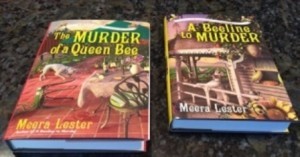Meera Lester's Blog
August 17, 2017
Why Keep Writing Materials Handy?
I’ve lost count of the exact number of published books I’ve written. I think it’s somewhere north of thirty. Most are nonfiction but for certain, three are novels. So you might think inspiration for a new book is always within my easy reach. Well, it is and it isn’t. Let me explain.
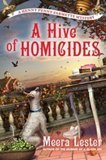
This novel is slated for Sept. 26 release and fits the cozy mystery genre
Ideas are always floating around in the universe. You might happen on one at the same time as ten other people. Me, too. But before I spend a year writing a book based on that idea, I take time to decide if the subject is suitable and complex enough for a book. Some story ideas are thin and best suited for becoming short stories, essays, blog posts, columns, or articles.
When inspiration strikes, I certainly stop what I’m doing, get up, and jot the idea into a notebook that I keep handy for that purpose. I do this even if I’m already writing on another story. I might make a notation right then and there that the idea could easily become a novel if I can come up with a suitable subplot or setting that can enrich the story as background or even become a character for the story. I might even consider possible subplots. Or, themes. And, most importantly, characters.

Just released, this book of guided meditations is organized around universal themes
Alternatively, you might think your idea is best suited for nonfiction. In that case, you’ll need an organizing principle–a way to organize the material so that the subject matter can be presented incrementally in chapters. Inside each chapter, you might further break down the subject with sections along with any special elements such as quotes or helpful tips or recipes.
Possibly, you might divide your subject matter into themes that span the seasons or weeks of the year. Or, you could elect to devote a chapter to each month of the year. Consider additional material such as action items at the end of each chapter or succinct summaries. Perhaps most importantly, you’ll have to decide into which nonfiction genre your idea best fits (for example, self-help, inspiration, biography, religious, family and parenting, history, reference, textbook, etc.). Fleshing out the seminal idea is often more fun than work.
Inspiring ideas sometimes take root in my psyche when I hear an interesting anecdote or learn something new in a subject that fascinates me (like the myriad ideas that came up for me during my recent reading of Daniel Lieberman’s book, The Human Body (biological anthropology). If I see value in a nonfiction book idea, I’ll jot down the idea and any tangential material it triggers with the intention of revisiting and developing that idea later at a later time.
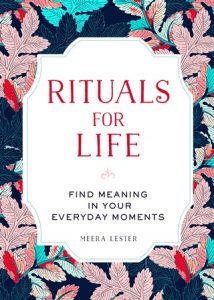
To be released in December, this self-help book focuses on rituals to add meaning to your life
Last year, my agent mentioned two words to me. Those two words got me so excited about writing a new novel that I went to work immediately crafting a backstory and a creating a forward-moving plot. Like I said, I don’t write the whole book when inspiration strikes, but instead, do my assessment and figure out if the concept can sustain several hundred pages. I can’t give away my agent’s two words here (they’re secret until my next mystery comes out), but suffice it to say that sometimes that’s all it takes to fire the imagination. And, yes, I wrote those words down and put them over my computer.
If the plot line needs some unexpected twists, I’ll revisit my trusty little notebook, turn to the tabbed section on plot ideas, and see if one or more fits. That’s why it’s important to keep your writing materials handy. You must have a place to keep all those ideas for easy access for when you are ready to begin the work of writing your Great American Novel or best-selling nonfiction book.
September 28, 2016
Don’t Just Sit There When Inspiration Strikes
Seized by an inspiring idea for a new writing project? Don’t just sit there. Grab a pen and some paper. Capture the idea before it drifts away.
The late Madeleine L’Engle once noted that when an idea for a new project taps you on the shoulder, it’s inviting you to birth it. Here are a few simple strategies for fleshing out your idea once you’ve captured it.
1. Consider whether fiction or nonfiction treatment best suits the inspired idea.
2. Determine the best form for it–screenplay, novel, nonfiction book, stage play, or poem.
3. Figure out the heart of the project and begin working on the form it will take. If you believe it’s best suited as nonfiction, you’ll need to flesh out the focus, slant, and factor (s) that distinguish it from other projects already in the marketplace. For fiction, consider what genre it would best fit (that in turn will determine length, style, and other critical elements specific to each genre such as mystery, romance, young adult, sci-fi, fantasy, etc.).
4. Do some brainstorming. I like working with a bubble chart. My main idea goes in the middle of the page inside a bubble. Spokes radiate out into tangential thoughts triggered by the idea. This technique works well for a mystery novel, for example, that needs a few suspects and motivations for them.
5. Consider whether your inspired idea could be the base of an “empire” of information, pieces of which could be spun off into multiple stories or a series. Or, would your project fit into an already existing series of books?
6. Develop a dynamite synopsis if your idea is for a novel; create a killer book proposal if the idea is for a nonfiction book. For a nonfiction project, indicate the nonfiction category such as self-help, how-to, home/garden, cooking, psychology, history, travel, photography, biography, child-rearing, autobiography, memoir, hobby, sports, and health and wellness, to name a few.
When I got the idea for a mystery based on my real-life farmette dramas, it came after I’d had nearly two dozen nonfiction books published (some were sold into an existing series such as Adams Media’s “Everything” series of books).
I’d also established a blog and had been building a brand based on my life renovating the old farmette. My first novel–A BEELINE TO MURDER–sold as a three-book contract and featured my Henny Penny Farmette brand and a farming milieu.
Working professional writers don’t wait for inspiration to strike. That said, they don’t take it for granted. Most will at least capture the idea. That way, if there isn’t time to go to work on it immediately, they can revisit it later.
September 8, 2016
Coming Full Circle
Even as I gear up for publicity on my forthcoming book, THE MURDER OF A QUEEN BEE, I am taking a little time to reflect on my just-finished third novel in the Henny Penny Farmette series. Deep breath. I confess I’m feeling a bit disoriented.
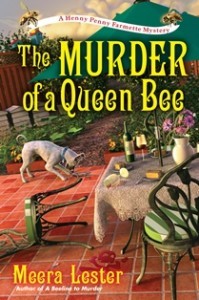
This novel is the second in the Henny Penny Farmette series that began with A BEELINE TO MURDER
It’s as though I’ve climbed a mountain that demanded a lot of mental and physical energy while writing and pacing to the finish on that third novel that arcs the series. And now that I’ve descended that mountain, my thoughts, feelings, and bodily energy must shift back to who I was before that story claimed most of my waking hours over the last year.

Nature nourishes the spirit and renews creativity
I think it must be true of all fiction writers that we leave bits of ourselves strewn throughout our stories. But in the end, we realize the scattered bits are and have always been part of us. After the writing is done, we relegate those bits to memory (where all our experiences in life are stored) and move back into our natural rhythm. Like flower stalks in the wind, we bend against the force and then when the pressure stops, we return upright. We are rooted as before albeit often changed.
Through the passage of time and the process of writing, I learn, evolve, grow older. During the writing of a book, I’m obliged to answer lots of questions and to dig deep into myself in order to understand the why’s. Poet T. S. Eliot ‘s lines ring true for me: And the end of all our exploring/Will be to arrive where we started/And to know the place for the first time.
“Let yourself be drawn by the stronger pull of that which you truly love.” –Rumi
With no new immediate deadline looming on a new project, I sit in my garden and write about these feelings in my journal. I watch the bees forage on the lavender and the scrub jays feed on the sunflowers that have become massive seed heads. The dry seed heads hang low on ten-foot stalks now that it’s September. The water falling from the Italian fountain coos a quiet lullaby. Breezes cool my face. Sitting, observing,and journaling is how I knit myself into wholeness again. In nature and silence and over time, I begin to feel the impulses calling me to a new beginning. I scribble out a title, describe a character, write down a name. So . . . the cycle to start a new story begins anew.
June 17, 2016
Ten Prompts to Get You Started Writing Your Novel
Where do you get ideas for your novels and how do you start writing your story? These are often the first questions a beginning writer asks a published author. For me, ideas are everywhere. You can start a story with an intriguing character, unusual setting, a moral dilemma, or a dramatic event. All can be twisted and spun in directions to serve the storyteller’s purpose.
Perhaps the easiest way to get started is to know what subject inspires you to want to know more about a particular topic. What genres do you like to read? Before sitting down to write a novel for a particular genre, understand the criteria and constraints of that genre. In that way, you’ll avoid a lot of beginner mistakes.
Before you start drafting your story, consider the definition of the verb, “shift.” This word has huge relevance to novel writing and, in particular, to plotting. Shift means to move a person or thing to a different place or position; or, to cause something to change a belief or opinion. The emphasis is on moving. And not simply a linear movement from beginning to end but movement with dramatic rising and falling action. It’s that kind of movement that all good stories have.
1. Choose a genre such as mystery, women’s fiction, romance, historical fiction, science fiction, fantasy, or young adult and then read books and also synopses of published books in your chosen genre. Reading stimulates the flow of ideas. Take a shot at writing a one-page synopsis of the novel you want to write.
2. Make a list of six or eight characters from the world’s political, cultural, scientific, artistic, or humanitarian arenas who intrigue you. Thinking about what you know about each character, create another list of positive traits and character flaws. Characters drive plots based on their hidden desires, goals, and the choices they make. Start your novel with an intriguing character. Even better, start your novel with an intriguing character who has a goal with high stakes if that goal is not met or a deep (perhaps dark) secret and a reason to keep that secret at all costs.
3. Select a dramatic setting. For example, think of a local, national, or world setting in which something dramatic has happened. Change the locale, spin the story in a different direction, and use an interesting character at the heart of the story to drive it forward.
4. Start with a what-if question. Imagine an ordinary day in the life of your character and change it up by asking lots of what-if questions that will then turn into an extraordinary dramatic opening to set your story in motion. It’s the equivalent of thrusting the gear shift on the engine (of your story) into driving it forward.
5. Wound your character. It’s great to have heroic characters with stellar traits and abilities. But a deep-seated wound gives a dimension that can cause a character to make wrong choices, thus creating more havoc and drama for her. This wounding can serve as a character flaw if it blinds the character in some way to staying on purpose. Plus, such a wound can cause a character to unwittingly put others at risk by making choices that avoid probing the wound. Never make life or choice easy for your main character.
6. Put two lovers together (or, an individual and the person, place, or thing he loves most in the world) and then rip them apart. Despite all odds and the desire (plus the goal) to reunite, make it virtually impossible until they overcome the final hurdle to come back together.
7. Create a catastrophic situation and characters who will prevail against all odds (man v. man, man v. nature, man v. self).
8. Imagine your character faces a moral dilemma. It could have implications for a whole community (a local doctor in a rural area with a drug problem, a church treasurer who is embezzling from a crisis fund, an auto mechanic who settles grudges by tampering with the cars of his enemies).
9. Rewrite an old newspaper obituary, changing the person’s gender. Starting with the manner of death, ask what-if questions to take the person’s life in a different direction.
10. Start with a dramatic setting–a refugee camp where a killer lurks, a river’s spring thaw exposing a body, a business torched by a rival owner, an small commuter airplane in rapid descent destined to crash.
There are as many ways to plunge into story as there are writers wanting to take the plunge. If you are one of them, there’s no better time to start than now.
* * *
Meera Lester is the author of A BEELINE TO MURDER (Sept. 2015) and THE MURDER OF A QUEEN BEE (Sept. 2016) as well as her just-completed third novel (for Kensington Publishing) in the Henny Penny Farmette series of cozy mysteries. See, http://www.hennypennyfarmette.com
Her books are available online through Amazon, Barnes and Noble, Kobo Books, Walmart, and others as well as through traditional bookstores everywhere. Find her on Facebook.com/meera.lester and twitter.com/@MeeraLester. Also locate her on LinkedIn, Pinterest, and Google+.
October 15, 2015
Strudel, Chocolate, and Daydreams
Have you ever wanted to make the world go away for a few hours, a few days, or a few weeks? I guess that’s what vacations are for. And I haven’t had one of those in a few years. But I remember one on which my husband and I were on a mission–he wanted the find the best chocolate in the world, and I wanted to find the best apple strudel. We traveled to nine countries in Europe that autumn. He found his favorite chocolate in Belgium; I found my favorite strudel in an Austrian village.

Daydreaming and gardens go together, don’t they?
I haven’t felt much like going out into the world these days–although I’ve had BEELINE TO MURDER book publicity events in October and more coming up in November. For the last couple of days, though, I’ve been in a baking mood and just want to try out new recipes, work in my garden, watch the bees on the cosmos, and hang out daydreaming on my yard swing.
That’s not all bad because creative writers do some of their best thinking while doing mundane tasks or simply hanging out. Maya Angelou observed that every writer finds his or her own secret path to the muse. The renown mystery suspense writer Mary Higgins Clark once explained that she wrote her books after the kids had gone to bed, and she was doing the laundry. E.B. White once noted that delay is natural to a writer. “He’s like a surfer–he bides his time, waits for the perfect wave on which to ride in.” (Paris Review 1969)
So, while I hang out, I can think about which recipes to include in the new novel I’m writing. The more mouth-watering, the better. This novel will be number three in the Henny Penny Farmette series and have tie-ins to an artisan chocolatier and a winery. It should be the most fun yet in terms of the recipes. I mean even if things go somewhat badly, chocolate and wine will always make you feel better. Right?
September 29, 2015
NOVEL DEBUT TODAY!
A BEELINE TO MURDER, the first book in my Henny Penny Farmette series of cozy mysteries makes its debut today. Last night when my head hit the pillow, I reminded myself that I would go to sleep as an unpublished novelist and awaken in the morning a published novelist. Today is all about the emotional high. My box of novels arrived on the doorstep at nine o’clock. Flowers from my Scribe Tribe arrived at ten. What a joyful start to the day.
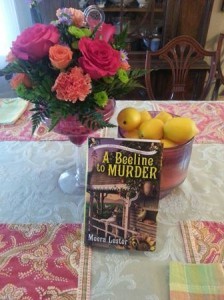
My first book in the Henny Penny Farmette series is A BEELINE TO MURDER
Getting your very first novel published only happens once in a lifetime. It’s akin to birthing your firstborn child but magnified tenfold. What an absolute thrill!
Novel writing, noted George C. Chesbro, is a “long-distance run of the imagination and will . . . .” For my Henny Penny Farmette series, I brought my whole life to the table. Agents will tell you when you approach them with a series that you can’t hold back material from the first book thinking that you’ll save something for the second or the third. If the first book doesn’t sell, you can forget about the second and third.
You have to put your heart and soul into that first novel. It’s also folly to believe you can crank it out perfect on the first draft. Great writing comes about through the process of rewriting when you can prune away excess verbiage or even entire scenes. You fix pacing, take out stumbling blocks and pitfalls, intensify emotion, write in emotional peaks and valleys, and polish to a high shine. It might take several rewrites. You might even want to deep freeze the novel to read it with fresh eyes months later.
At some future time, I want to write a blog about narrative voice. A lot of novels never find their way to publication because the editor or agent isn’t connecting with the narrative voice. I know this because I wrote five novels that mercifully will never see the light of publication because of the voice. When I wrote A Beeline to Murder, it was the voice that endeared itself as authentic and engaging to my agent and editor. Finally, I’d found it.
Over the years, I met many friends who aspired to having their first novels published. To them, I say, do not give up on your dream. Bring all your life experience to the table. Write your heart out. Rewrite until the work shines and the prose sings. And rewrite again.
The debut day of your novel will be spectacular. I know mine is.
August 19, 2015
Opening Yourself to the Wild Place Within
One of my favorite authors, the late John O’Donohue, wrote in his exquisitely rendered book, Eternal Echoes (Harper Perennial 2000), that our habits “close us off from the unknown, the new, and the unexpected.” Living life along the familiar pathways of habit, we reduce and limit our creative side, he admonished.
Similarly, when we resort to using the same words and phrases, we also limit ourselves within the reach of our vocabulary. Observing this, O’Donohue noted that when we name something, we are giving it an identity. Yet, that very name can trap a person, place, thing, idea, or experience. Names, he felt, had to be worthy and spacious and, therefore, we humans must try always to thoughtfully choose the names we give such things.

In the creative imagination or dreaming mind, a rose can symbolize love, beauty, spiritual desire, passion and purity
LABELS AND NAMES
I’ve thought a lot about the artistic inventiveness that creativity implies. The unnamed place deep within each of us is a limitless wild place. When we turn within, names of things and the names we call ourselves and other as well as the labels we put on things fall away. We experience the inner world without language. There are no walls to hold us. Our creative self expands in imaginative and inventive ways to touch inner landscapes, foreign and familiar. We are invited to explore, expand, and receive the unknown. The gifts therein are ours to claim.
Writers and artists are especially receptive to crossing the inner threshold where boundaries do not exist. In that void of silence, they rejuvenate their creative imaginations, receive inspiration, and become transformed by a richly imaginative landscape.
RESPONSE TO INSPIRATION
Our creative ideas come from within our imaginations, not from a source outside of us. That’s not to say external objects or events cannot trigger an inspiring idea. Inspiration means in its most literal sense a “breathing in.”
The inspired idea takes hold in our creative imagination where we then accept, reject, make linkage with other ideas, refine, and otherwise process the thoughts that arise around the trigger. We are the progenitors and curators of the ideas that emerge from our creative processes. Thus, opening ourselves to that wild place within is vital if we are to create our art, literary endeavors, or find the way to a scientific breakthrough.
INNER PATHWAYS
There are myriad departure points on the path inward. Classical or quiet devotional instrumentals can pull one inward. Essential oil scents or incense can also do the trick. Communing with nature, daydreaming, meditating, taking mindful walks, and writing in a dream journal about your nighttime journeys help you tap that inner wild place. There are other ways, of course. Whichever path you might choose, take time to open yourself to that wild place within and be prepared to expand your creative side.
August 17, 2015
Why Rewriting Matters
Having written nearly two dozen published nonfiction books, I soon realized that fiction is a whole other kind of work. Stringing words together is not the same as crafting a compelling narrative with interesting characters and a memorable milieu. Additionally, the story has to work as a mystery. My debut novel benefited from many rewrites.
Finally, my agent showed the work to an editor who said she liked the narrative voice and the "strong" writing, but balked when I broke so many rules of convention for a cozy mystery.
Another complete rewrite later, and the book passed muster. But over the course of developing that book into a viable novel that would satisfy the publisher and readers, I did a lot more work on it. When I note that rewriting matters, I'm not kidding. It can make the difference between prose that sings and a story that hooks you all the way to the end and one that doesn't. Simple as that.

January 31, 2015
Plot Lines, Character Arcs, and Narrative Arcs
Plot lines, character arcs, and narrative arcs are elements of the dramatic structure in storytelling. The plot of a story is like the main thread that reveals the unfolding of events. The secondary thread in the fabric of a novel is a subplot, often call the “B” plot. The “B” or subplot intersects the main plot, either through the protagonist or secondary characters with linkage through time, place, or theme.
Pyramid of Dramatic Structure
The A plot and B plot can both have the dramatic story structure: Exposition. Rising action. Climax. Falling action. Denoument. It is often in the “A” plot line where you’ll find the character arc of the protagonist as he or she must acquire new skills to deal directly with the antagonistic elements or individuals in his/her environment as the story unfolds. But the “B” plot is different from the main plot line often because the protagonist is dealing with a personal fault or problem secondary to the “A” plot. Still, he or she must gain new awareness, skills, inner growth tools, and the like and will experience a character arc as a result of the “B” plot.
Secondary Character Arc
Not only does the protagonist’s character arc, but it is also possible for a secondary character to have an arc as well. The change can be profound in the inner life of a character. Narrative arcs and story arcs are often pictured as a half circle dome.
In a three-act structure film or novel, the main plot starts the main character through setting him in an environment as the story begins. Then comes the inciting incident or something that the protagonist must confront that starts the story’s momentum and carries the plot forward to the next (often more dramatic) incident.
First Turning Point
In a three-act structure, this opening with the second incident would be noted as the first turning point of the story. It is this first sequence of plot that sets up the drama’s story question; that story question is the one that gets answered in the climax of the book or film.
Start of the Character Arc
It is in the second act, that the character arc begins to evolve. When the protagonist tries to resolve the problem of that first turning point, it makes things worse and he must learn new skills or acquire new knowledge to deal with the worsening problem or situation. This profound change in the protagonist happens along plot line A, usually late in the second act.
Narrative Arc
Armed with knowledge or skills, but changed, the protagonist’s story reaches a climax in the third act with the rising action hitting its highest dramatic point (the climax) and then falling (resolution of problem and story question answered), followed by the denouement which completes the narrative arc of the story. The character experiences a higher level of self awareness but this does not mean the character arc is complete as the character can continue to evolve in the next novel or film sequel or story. This is the secret of storytellers: keep the beloved character evolving to keep readers wanting more of that character.
December 16, 2014
A Weekend of Mystery

Long Beach’s beautiful yacht harbor where you can walk the promenade or hop on board a boat for a 45-minute trip to refresh your body, mind, and spirit
Bouchercon 45 (an annual behemoth of a mystery conference) lived up to all its hype and then some. I admit, as a newbie fiction author, I was slightly overwhelmed at the opulent offerings of seminars, panels, author presentations, autograph sessions, and special events during the four-day conference in Long Beach, California November 13-16, 2014.
I attended many sessions and filled an entire notebook with information and ideas. I sat in on all the cozy mystery presentations and attempted to connect with many cozy authors as possible.
Help is always advised when navigating through unfamiliar terrain and although I’ve published a lot of nonfiction and attended many nonfiction conferences, this is my first foray into novel writing and the world of mystery conferences.
I found the authors to be genuinely approachable, smart, funny, and exceedingly savvy about the genre as well as the current state of mystery publishing.
The cozy mystery presentations had clever titles like “Cute and Sweet, but with a Twist and also “A Fine Palate for Death: Dessert Wine and Crime.”
I particularly enjoyed seeing two cadaver dogs in action and hearing stories of “finds” during their handlers’ presentations.
There were panels and author signings, special events, international guests, and a silent auction–all adding up to four information-packed days of nonstop fun.
When my brain felt fried, my husband and I hopped on a boat for a cruise around beautiful Long Beach harbor. It refreshed and revitalized me so I could head back to the conference for more presentations and a visit to the large book room for my final purchases.
A meeting with my fiction editor and a lovely dinner celebrating the momentous 40th anniversary of Kensington Publishing was a highlight of the conference for me. During that dinner, I met other Kensington authors with whom I hope to have long, enduring friendships. Inspired, I could hardly wait to return home and get my fingers flying over the keyboard again!

